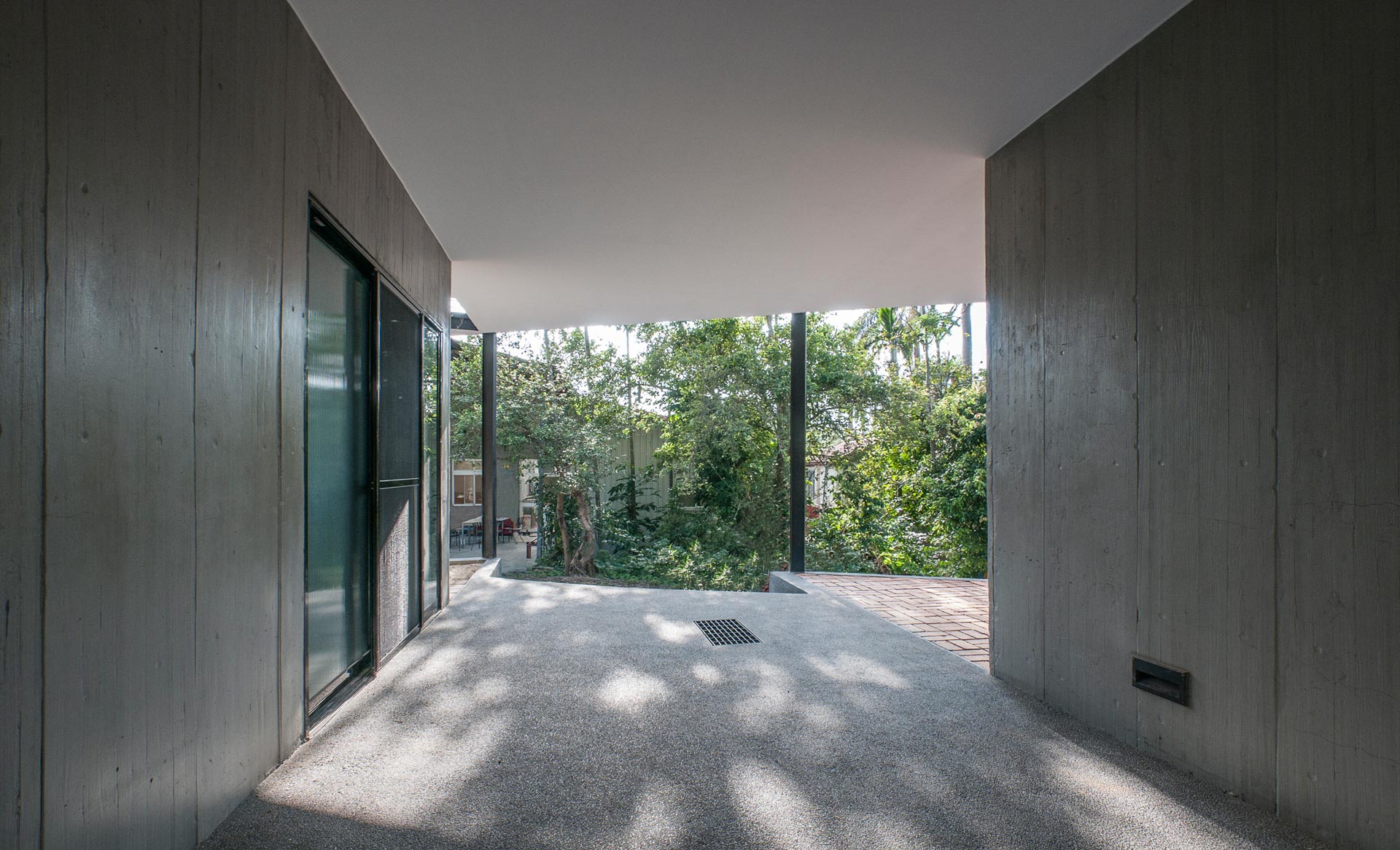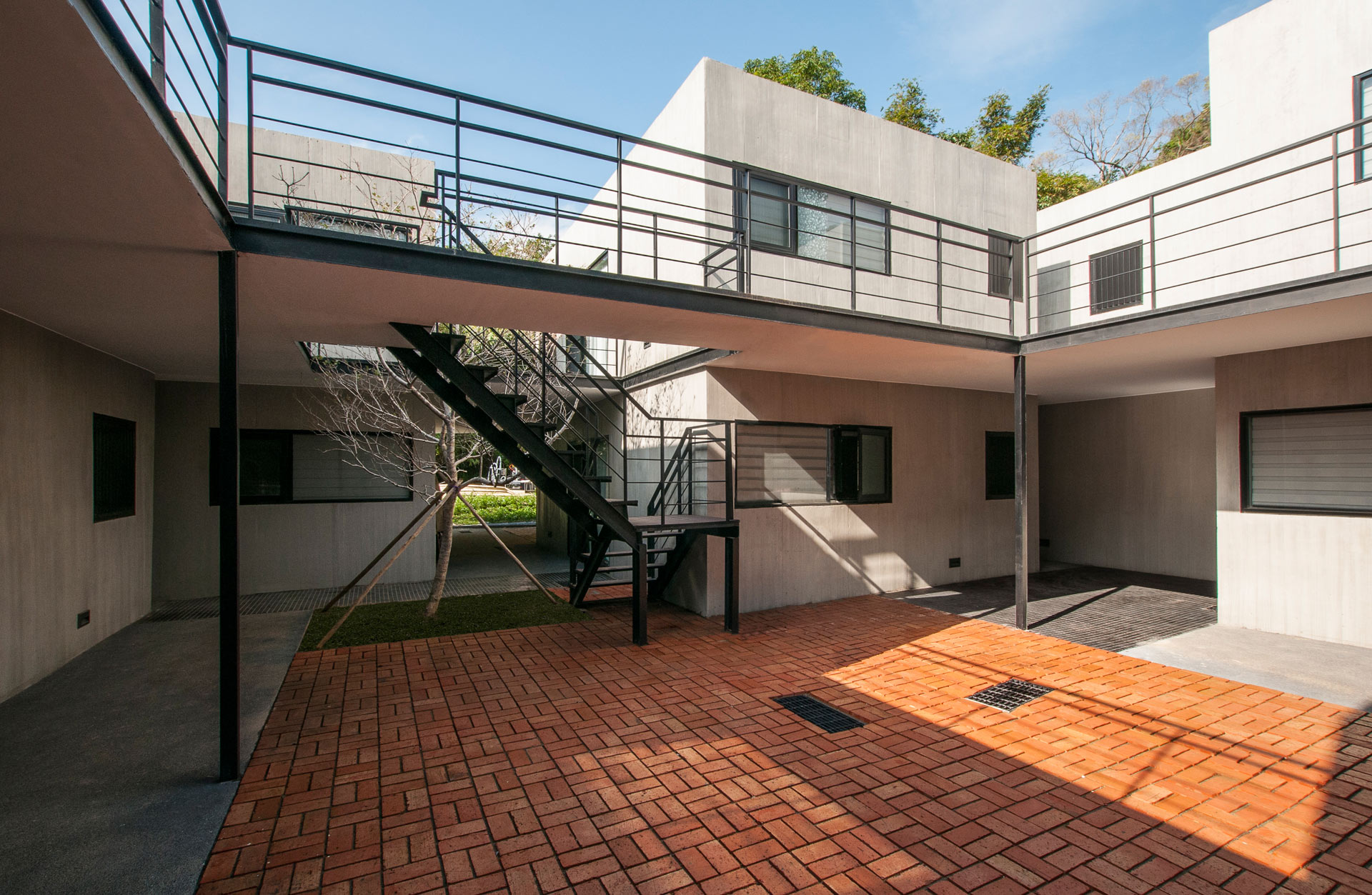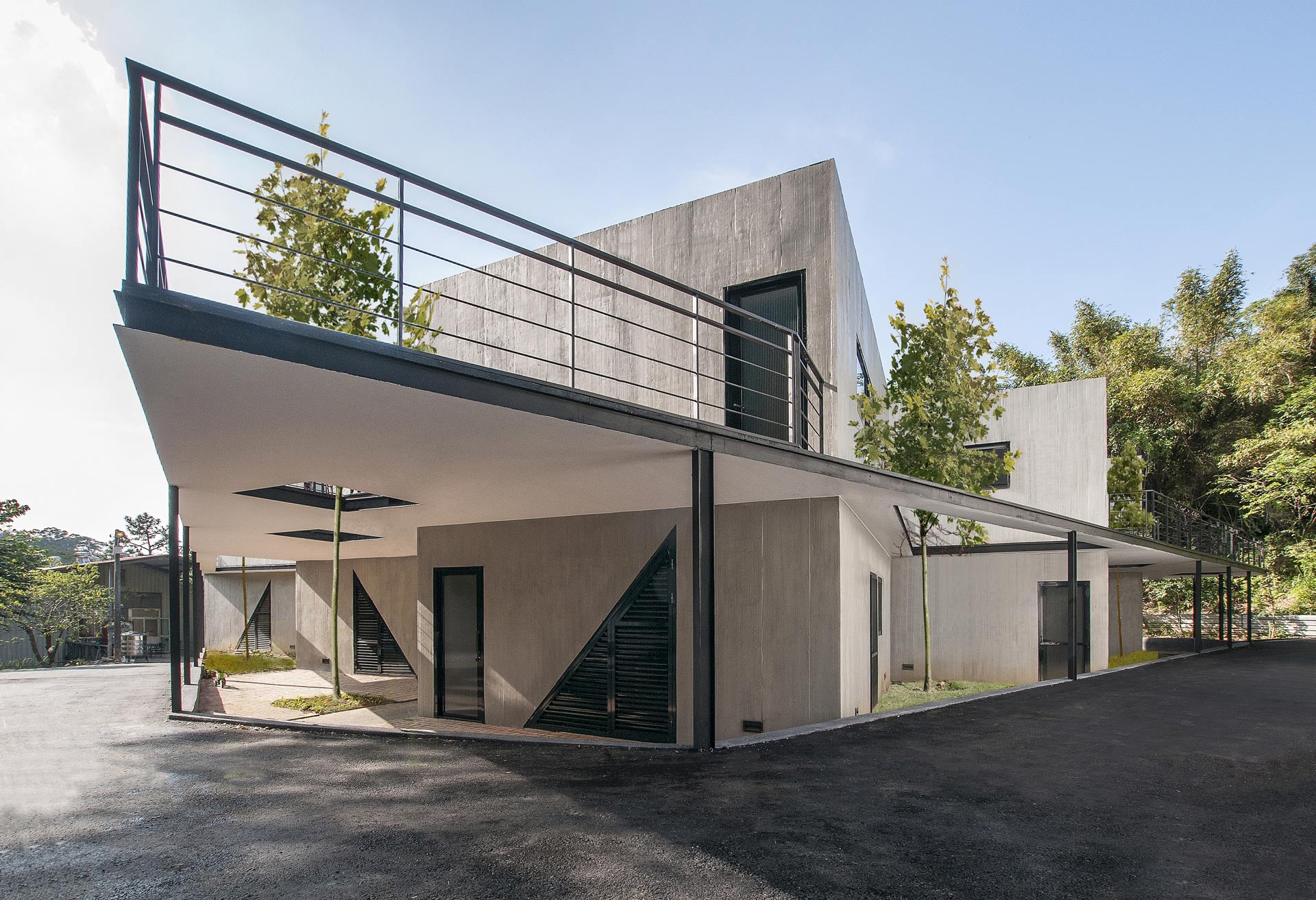Completion Year: 2016
Location: Taichung
Completion Year: 2016
Location: Taichung

滲入透出的微型聚落
Flowing Space of Natural Environment and Concrete Constructions for Tiny Urban Tribes
在地狹人稠的當代都市,城市規劃者與建築師幾乎時時刻刻思索著:如何爭取更多的居住空間?這個議題在上世紀現代主義提出以Domino系統為基礎的鋼筋混凝土高層建築後似乎得到了暫時的紓困,而我們的城市也隨之變成國際樣式(International style)下的水泥叢林,就在容積、建蔽、公設比的精打細算中,大型高密度集合式的住宅樓群應運而生,成為絕大多數已開發都市的典型地景。而人們的生活與思維,似乎也被迫縮身於與鄰人劃清界線的小框框裡。偶爾人們會奢侈地想念起,過去農村裡開闊寬敞的合院空間,曬著稻穀菜乾的大院裡,孩子們在陽光下嬉戲笑鬧,大人閒坐一旁乘涼聊天,泡茶下棋。這番景象,難道真的只能是過去式了嗎?
In a densely populated contemporary city, all the city planners and architects reflect, from time to time, how to make an effort in order to gain more living spaces. This difficulty has been temporarily relieved by reinforced concrete high-rise buildings advocated by Domino System in last century of modernism. For that reason, our cities then become a concrete jungle in international style. With a detailed project of space, building coverage and ratio of public utility, a huge and high-density community with multiple-family residential house comes to the world. It became a typical view for most of developed cities. After that, it seems people’s life and thinking are restricted to a limited space as they established boundaries with neighbors. Nowadays, people are still missing the large garden area of courtyard houses in countryside in olden times. On a grain-and-dry-vegetables sunning ground, children played with each other under the sun, and adults sat, talked with each other, played Chinese chess and drank tea under the sun shelter. Then we ask ourselves, can’t this scene be realized at present?

水泥叢林中的現代合院聚落
A Modern Courtyard Settlement Within a Concrete Forest
基地是位於新竹縣寶山鄉一處由自然環境所懷抱的郊區,與新竹科學園區相距甚近,不僅交通方便,竹林綠帶所圍朔出的隧道也成為最好進入此基地的入口意象。本案是舊建築改造成新型態的聚落社區,我們希望將傳統集合式住宅社區與合院結合,使自然與生活兩者皆能兼具,創造出更豐富多元的生活環境。
The site is located in a rural area of Baoshan, Hsinchu, surrounded by nature. It is conveniently situated in close proximity to the Hsinchu Science Park and the entrance tunnel to the site is most adequately encased with bamboo forests and greeneries. This project involves the renovation of old architecture into a new form of community settlement. We hope to bring together traditional congregated housing community and traditional courtyard to create a rich and diversified living environment that suffices both natural and lifestyle factors.

遊移的縫隙,共用經濟的生活理念
Wobbling Splits - Living Concept of Sharing Economy
本案是個微型聚落的計畫,我們思索現代社區經營理念與傳統合院聚落精神融合的可能性。現代集合式社區的特色是一個蘿蔔一個坑,戶與戶之間形成涇渭分明的楚河漢界。然而在劃分界線的同時,也割裂了人與人之間的聯繫交流,且也浪費了不少精力來建立「界線」,在這整體大環境的氛圍及涵構脈絡中,真正合院精神的建築簡直是難以實現的奢侈要求。
This is a project specializing in tiny tribes. We contemplate the possibility of combining management concepts in modern community and community spirits of traditional courtyards. The main disadvantage of multiple-family residential house community is the indifferent boundaries among households. Once the boundaries are established, it stops the connection and interaction among people, and also waste an amount of time and energy setting « boundaries ». The environment with these circumstances and context, it is undoubtedly hard to realize the community spirit of traditional courtyards.

於是,我們翻轉了集合式住宅社區當中「界線」的思維,以錯落的手法規劃出一個近似「米」字的生活場域,取代「井」字的隔離觀望,而錯落間所產生不同尺度的「縫隙」,將有效讓人、動植物、風、味道從身旁的山間滲透流動進來,創造出與環境連結的公共半戶外空間。再者,這社區有個潛規則,每戶人家除了擁有自己獨立的門前小院外,同時每兩戶單元間都共用著一個可供栽種的院子,兩戶人家需商討後共同經營這個半戶外空間;同時,這的住戶有許多的外國藉朋友,不特定的聚會散佈在整個社區的角落,成為習以為常的事件風景(Event);此外,我們讓建物間的縫隙也遊移至二樓,有如天橋般串連各單元及身旁的地景,成為人們交流互動的絕佳場域。在這裡我們想消除公私領域的絕對壁壘,並透過設計的手法植入一個以共享經濟(Sharing economy)為基礎的社區生活理念。
Therefore, we overturn the « boundary » concept in multiple-family residential house, and we create a living area with a shape of « star key » on the phone in a scattered manner. It replaces the shape of « pound key » leading to isolation. And the « splits » in different scales caused by scattered style can make people, animals, plants and wind in the mountain flow into the area, which creates a public semi-outdoor space connecting with the natural environment. Moreover, the community with this style has an implicit rule; that is, each household possesses not only an independent little garden but also a planting field shared by two households. These two households need to discuss how to deal with this shared semi-outdoor space. In the meantime, there will be many foreign people living in and non-specific gatherings taking place in the community. In that way, such event will become a habitual scene for everyone. More and above that, we move the splits of building to the second floor, which connects all the units and scenes, will be the best place for people to interact and communicate with each other. We are going to disperse any public and private boundaries in this place and sketch a fundamental community living concept of sharing economy.

